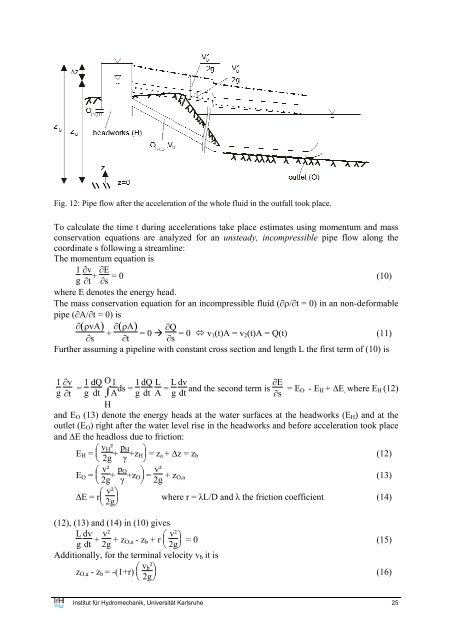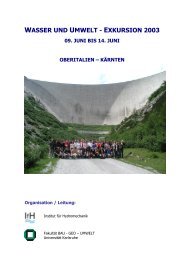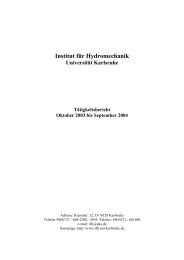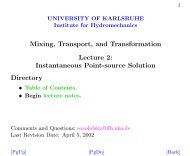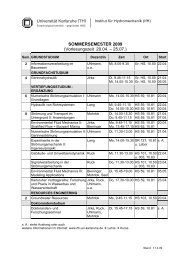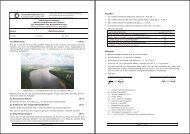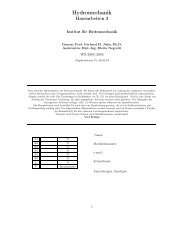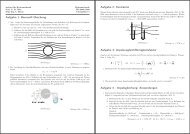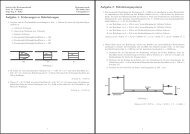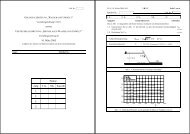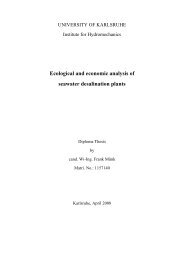user's manual for corhyd: an internal diffuser hydraulics model - IfH
user's manual for corhyd: an internal diffuser hydraulics model - IfH
user's manual for corhyd: an internal diffuser hydraulics model - IfH
Create successful ePaper yourself
Turn your PDF publications into a flip-book with our unique Google optimized e-Paper software.
Fig. 12: Pipe flow after the acceleration of the whole fluid in the outfall took place.<br />
To calculate the time t during accelerations take place estimates using momentum <strong>an</strong>d mass<br />
conservation equations are <strong>an</strong>alyzed <strong>for</strong> <strong>an</strong> unsteady, incompressible pipe flow along the<br />
coordinate s following a streamline:<br />
The momentum equation is<br />
1 ∂v<br />
g ∂t + ∂E<br />
∂s = 0 (10)<br />
where E denotes the energy head.<br />
The mass conservation equation <strong>for</strong> <strong>an</strong> incompressible fluid (∂ρ/∂t = 0) in <strong>an</strong> non-de<strong>for</strong>mable<br />
pipe (∂A/∂t = 0) is<br />
∂( ρvA)<br />
∂( + ρA)<br />
= 0 ∂Q<br />
∂s ∂t ∂s = 0 v 1(t)A = v 2 (t)A = Q(t) (11)<br />
Further assuming a pipeline with const<strong>an</strong>t cross section <strong>an</strong>d length L the first term of (10) is<br />
1 ∂v<br />
g ∂t<br />
= 1 dQ O1<br />
g dt ⌡ ⌠ A ds = 1 g<br />
H<br />
dQ<br />
dt<br />
L<br />
A = L g<br />
dv<br />
∂E<br />
dt<br />
<strong>an</strong>d the second term is<br />
∂s = E O - E H + ∆E , where E H (12)<br />
<strong>an</strong>d E O (13) denote the energy heads at the water surfaces at the headworks (E H ) <strong>an</strong>d at the<br />
outlet (E O ) right after the water level rise in the headworks <strong>an</strong>d be<strong>for</strong>e acceleration took place<br />
<strong>an</strong>d ∆E the headloss due to friction:<br />
E H = ⎜ ⎛ v H ²<br />
⎝ 2g + p H<br />
γ +z H<br />
⎠ ⎟⎞ = z a + ∆z = z b (12)<br />
E O = ⎜ ⎛ v²<br />
⎝ 2g + p O<br />
γ +z O<br />
⎠ ⎟⎞ = v²<br />
2g + z O,a (13)<br />
∆E = r⎜ ⎛ v²<br />
⎝ 2g⎠ ⎟⎞ where r = λL/D <strong>an</strong>d λ the friction coefficient (14)<br />
(12), (13) <strong>an</strong>d (14) in (10) gives<br />
L dv<br />
g dt + v²<br />
2g + z O,a - z b + r ⎜ ⎛ v²<br />
⎝ 2g ⎠ ⎟⎞ = 0 (15)<br />
Additionally, <strong>for</strong> the terminal velocity v b it is<br />
z O,a - z b = -(1+r) ⎜ ⎛ v b ²<br />
⎝ 2g⎠ ⎟⎞<br />
(16)<br />
Institut für Hydromech<strong>an</strong>ik, Universität Karlsruhe 25


